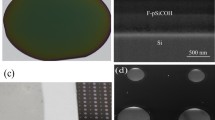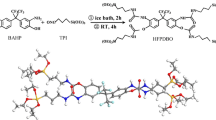Abstract
Integrating porous low-permittivity dielectrics into Cu metallization is one of the strategies to reduce power consumption, signal propagation delays, and crosstalk between interconnects for the next generation of integrated circuits. The porosity and pore structure of these low-k dielectric materials, however, also affect other important material properties in addition to the dielectric constant. In this paper, we investigate the impact of porogen loading on the stiffness and cohesive fracture energy of a series of porous organosilicate glass (OSG) thin films using nanoindentation and the double-cantilever beam (DCB) technique. The OSG films were deposited by plasma-enhanced chemical vapor deposition (PECVD) and had a porosity in the range of 7−45%. We show that the degree of porogen loading during the deposition process changes both the network structure and the porosity of the dielectric, and we resolve the contributions of both effects to the stiffness and fracture energy of the films. The experimental results for stiffness are compared with micromechanical models and finite element calculations. It is demonstrated that the stiffness of the OSG films depends sensitively on their porosity and that considerable improvements in stiffness may be obtained through further optimization of the pore microstructure. The cohesive fracture energy of the films decreases linearly with increasing porosity, consistent with a simple planar through-pore fracture mechanism.









Similar content being viewed by others

References
M.L. O'Neill, R.N. Vrtis, B.K. Peterson, M.K. Haas, S.J. Weigel, D. Wu, M.D. Bitner, E.J. Karwacki: Impact of pore size and morphology of porous organosilicate glasses on integrated circuit manufacturing, in Materials, Technology and Reliability of Low-k Dielectrics and Copper Interconnects, edited by T.Y. Tsui, Y-C. Joo, L. Michaelson, M. Lane, and A.A. Volinsky (Mater. Res. Soc. Symp. Proc. 914, Warrendale, PA, 2006), 0914-F01-02.
K. Maex, M.R. Baklanov, D. Shamiryan, F. Iacopi, S.H. Brongersma, Z.S. Yanovitskaya: Low dielectric constant materials for microelectronics. J. Appl. Phys. 93, 11 8793 2003
M. Morgen, E.T. Ryan, J.H. Zhao, C. Hu, T.H. Cho, P.S. Ho: Low dielectric constant materials for ULSI interconnects. Annu. Rev. Mater. Sci. 30, 645 2000
S. Nemat-Nasser, M. Hori: Micromechanics: Overall Properties of Heterogeneous Materials, 2nd rev. ed. Elsevier Amsterdam 1999
R. Roscoe: The viscosity of suspensions of rigid spheres. Br. J. Appl. Phys. 3, 8 267 1952
R.M. Christensen, K.H. Lo: Solutions for effective shear properties in 3 phase sphere and cylinder models. J. Mech. Phys. Solids 27, 4 315 1979
Y. Benveniste: A new approach to the application of Mori-Tanaka theory in composite-materials. Mech. Mater. 6, 2 147 1987
J.D. Eshelby: The determination of the elastic field of an ellipsoidal inclusion, and related problems. Proc. R. Soc. London, Ser. A 241, 1226 376 1957
R.W. Rice: Evaluation and extension of physical property-porosity models based on minimum solid area. J. Mater. Sci. 31, 1 102 1996
S. Torquato: Effective stiffness tensor of composite media. 1. Exact series expansions. J. Mech. Phys. Solids 45, 9 1421 1997
A.P. Roberts, E.J. Garboczi: Elastic properties of model porous ceramics. J. Am. Ceram. Soc. 83, 12 3041 2000
A.P. Roberts, E.J. Garboczi: Computation of the linear elastic properties of random porous materials with a wide variety of microstructure. Proc. R. Soc. London, Ser. A 458, 2021 1033 2002
L.J. Vandeperre, J. Wang, W.J. Clegg: Effects of porosity on the measured fracture energy of brittle materials. Philos. Mag. 84, 34 3689 2004
E.P. Guyer, M. Patz, R.H. Dauskardt: Fracture of nanoporous methyl silsesquioxane thin-film glasses. J. Mater. Res. 21, 4 882 2006
Y. Lin, Y. Xiang, T.Y. Tsui, J.J. Vlassak: PECVD low-permittivity organosilicate glass coatings: Adhesion, fracture and mechanical properties. Acta Mater. 56, 17 4932 2008
M.R. Baklanov, K.P. Mogilnikov, V.G. Polovinkin, F.N. Dultsev: Determination of pore-size distribution in thin films by ellipsometric porosimetry. J. Vac. Sci. Technol., B 18, 3 1385 2000
Y.B. Lin, T.Y. Tsui, J.J. Vlassak: Octamethylcyclotetrasiloxane-based, low-permittivity organosilicate coatings—Composition, structure, and polarizability. J. Electrochem. Soc. 153, 7 F144 2006
Y.B. Lin, Y. Xiang, T.Y. Tsui, J.J. Vlassak: PECVD low-permittivity organosilicate glass coatings: Adhesion, fracture and mechanical properties. Acta Mater. 56, 17 4932 2008
W.C. Oliver, G.M. Pharr: An improved technique for determining hardness and elastic-modulus using load and displacement sensing indentation experiments. J. Mater. Res. 7, 6 1564 1992
X. Chen, J.J. Vlassak: Numerical study on the measurement of thin film mechanical properties by means of nanoindentation. J. Mater. Res. 16, 10 2974 2001
M.F. Kanninen: Augmented double cantilever beam model for studying crack-propagation and arrest. Int. J. Fract. 9, 1 83 1973
S. Li, J. Wang, M.D. Thouless: The effects of shear on delamination in layered materials. J. Mech. Phys. Solids 52, 1 193 2004
A.P. Roberts, E.J. Garboczi: Elastic properties of model random three-dimensional open-cell solids. J. Mech. Phys. Solids 50, 1 33 2002
J.J. Vlassak, Y. Lin, T.Y. Tsui: Fracture of organosilicate glass thin films: Environmental effects. Mater. Sci. Eng., A 391, 1–2 159 2005
Acknowledgments
This research was supported by the Semiconductor Research Corporation (Task ID: 1292.010). The OSG film stacks were provided by Texas Instruments Incorporated. The help of Nancy Ota with nanoindentation measurements is also gratefully acknowledged.
Author information
Authors and Affiliations
Corresponding author
Rights and permissions
About this article
Cite this article
Li, H., Lin, Y., Tsui, T.Y. et al. The effect of porogen loading on the stiffness and fracture energy of brittle organosilicates. Journal of Materials Research 24, 107–116 (2009). https://doi.org/10.1557/JMR.2009.0005
Accepted:
Published:
Issue Date:
DOI: https://doi.org/10.1557/JMR.2009.0005



